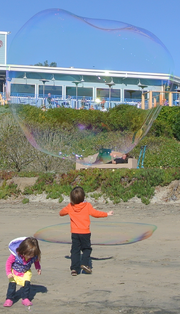Lighting bubbles to best effect is a tricky subject and the legendary Tom Noddy offered this brilliant reflection on lighting bubbles in response to a question on SBF, the Soap Bubble Fanciers Yahoo Group (RIP) about how to light bubbles at night.
Tom Noddy's Post[]
If you want to see the bright multi colors that are natural to bubbles, you will see them in the areas of the bubble where the bright white light is reflecting.

On a sunny day each bubble reflects the sun twice. So there are two bright white light areas, tiny ones. If you watch those little sun spots you will see the colors move across it but you won’t see as much color on the other parts of the bubble. Overall, not a very colorful display.

With the right conditions, the bubble colors can be seen clearly. Juice: eGoo with excellent lighting conditions.
On a bright cloudy day, the entire bright white sky reflects on each bubble... TWICE. The whole bubble is lit with color and you can see that best if you view it against the dark backdrop of distant trees or other darkness.
It isn't always possible (it isn't always desirable either) to see all of that color but if that's what you want and it isn't a bright cloudy day then you need to re-create that circumstance. If you shine a single flashlight on to a night time bubble you will see that single spot reflected twice on the bubble ... as it was when we saw the sun reflected twice. Those little flashlight spots are, again, colorful. But it's just two spots. You could turn on a dozen such spots and that would result in two dozen little light reflections on each bubble. That's actually not bad and it is essentially what we do when we ask the lighting tech guy in a theater to light us on stage ...put on lots of lights ... they will sometimes hear that as "lots of light" and they will turn their few lights up very bright but that doesn't change things that much ... the reflected spots are brighter and the guy standing next to the bubbles is more brightly lit but it wasn't "more light" that we wanted, it was "more lights" more spots reflecting on the bubble. One spot (two reflections) does not, for the guy at the back of the theater, look like a sphere ... that's the case whether they are dull or bright, it is only two spots floating in space and the guy in the back can't see much else. But two dozen lights reflecting all over the bubble will show him the shape of the thing.
But those are still not super colorful bubbles (unless the guy is putting red and blue and green and yellow lights on it and then the bubble has many red and green and yellow and blue spots but we still don't see the wave interference colors that bubbles are noted for. To see that, we would need to recreate the bright cloudy sky. If, instead of shining many lights directly at the bubble, we shined the bright white light on to the white wall next to the bubble then the bubble would reflect that entire wall ..... TWICE. If you were to see this with a dark backdrop behind it you would see what you see on a bright cloudy day when looking at a bubble with distant darkness of trees behind it.
Those Christmas lights are nice though, huh? A straight string of lights is reflected over that curving sphere in a bendy way. The same would be true with a straight florescent tube. Multiple straight white tubes or strings of Christmas lights will give lovely patterns of bendy lines.
But look how quickly the reflecting light gets smaller as you move the source away from a bubble. Light a lighter or pen light on to a bubble and hold it very close. Two reflections of the flame or light (with the flame you can notice that one of them is upside down!) then move the flame back a few inches and the reflections get A LOT smaller.
So, proximity to the source is a key as well.
Then there is the matter that I hinted at above ... sometimes you do not want the reflecting light to fill the surface to the point that the viewers cannot see the bubble inside of the bubble or the swirling fog tornado or other inside object. Light is sometimes too powerful, it can hide as well as show things.
I said a lot there ... if it causes you to look closer at bubbles and at what the light is doing on them then I'm glad. There is great pleasure to be had in looking closely at what’s happening in the interplay of light and soap films. I encourage you to experiment with single and multiple spots of light and with large swaths of light. This is beauty that is worthy of a capital letter ... Beauty. Enjoy.
--Tom Noddy
Editor' Note: This post was lightly edited by Tom for clarity and correctness. So, you may notice differences between this and the post over on SBF.